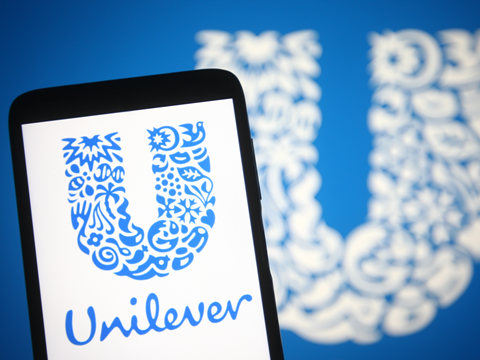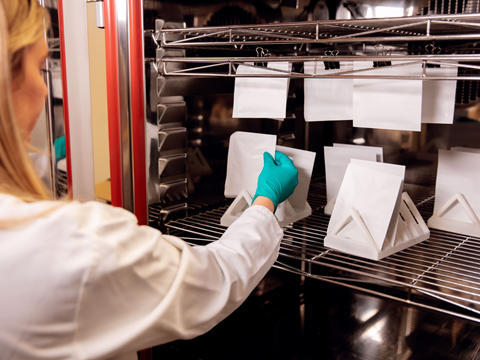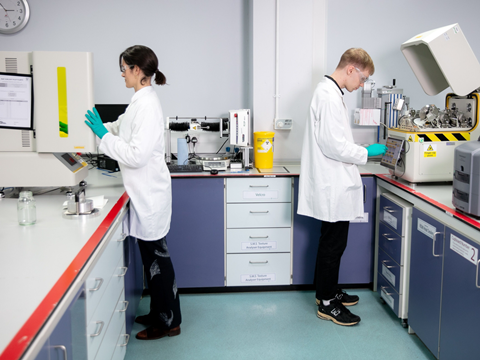
When we last spoke to Unilever about its controversial decision to extend the timeframe on its sustainable packaging targets, head of Packaging Pablo Costa said the company was “doubling down rather than watering down” its efforts. What does this mean in practice? Emma Liggins attended the company’s media roundtable to dive into Unilever’s revised sustainability strategy and its views on the upcoming Global Plastics Treaty.
By 2025, Unilever aspires to reach 25% recycled plastic in its packaging portfolio, and to collect and process more packaging than it sells. It is still on track to meet these targets, according to Costa; as of 2023, it reported that 22% of Unilever packaging contained recycled plastic, and that 61% of its product packaging was collected and processed at end-of-life.
Originally, the company sought to halve its virgin plastic consumption by the 2025 deadline. By 2023, it had lowered its virgin plastics by 18%, so the target has since been adjusted – now it plans to reduce 30% by 2026 and 40% by 2028, both against a 2019 baseline.
So, too, had the company originally intended to achieve a 100% recyclable, reusable, or compostable plastic packaging portfolio within the same time frame. As of last year, it stood at 53%, so the target has been pushed back and split in two: all rigid packaging is expected to meet these requirements by 2030, and flexibles by 2035.
Unilever attributes this particular revision to ongoing, sector-wide difficulties with recycling flexible plastics. Costa explained that the company sells more flexible packaging than rigid, even though it only comprises around 30% of its packaging portfolio by weight, thus slowing its current progress.
A refocused approach
Head of Packaging Technology and Operations Holly Nelson introduced attendees to the three tenets of Unilever’s ‘refocused strategy’. One of its methods is to alter existing materials and improve their sustainability credentials.
Colin Kerr, global head of Packaging Technology and Excellence, noted that the company’s global plastic footprint is approximately 700,000 tons, with 22% currently consisting of post-consumer recycled plastic (PCR) – a figure he concedes is “not enough”. Unilever is currently working to implement more mechanically recycled plastic into its packaging, but as Kerr explained, this is not a drop-in solution.
Not only are the functional properties of recycled plastics unsuitable for certain applications, but the smell, colour, and consistency of the recyclate can be off-putting to consumers – making it especially unsuitable in personal care applications, for example, where perceptions of uncleanliness could damage the brand’s reputation.
These features can also change from batch to batch, which has previously limited Unilever’s control over the appearance of PCR packaging.
To overcome these challenges, Unilever’s R&D team is utilizing a digital tool to virtually experiment with materials and designs before they are brought to market – for example, by predicting the colour of plastic recyclate. This negates the need to make a physical prototype and conduct physical tests or factory trials, which apparently lowers development time by around 25%. So far, this process has characterized 160 grades of recycled plastic content in 2024.
Furthermore, the company communicates with its recycled plastic suppliers to understand the properties of their recyclate, as well as help them install new equipment (e.g. deodorization technology) and improve PCR quality. It has reportedly expanded from a supplier base of two to over sixty, but this is an ongoing process.
Kerr highlighted the company’s plans to implement PCR wherever it can, yet he added that this is not a silver bullet – recycled material is not suitable for every application. Therefore, another approach is to transition into alternative materials.

One example cited by Nelson was its Pot Noodle brand, which was previously trialled in an FSC-certified paper pot. These pots were reportedly recyclable at home via existing cardboard and paper streams, with their thin layer of barrier plastic – a necessary addition to prevent water damage and product spoilage – thought to make no difference to the pack’s recyclability.
When developing alternative flexible packaging materials, Costa explained, Unilever considers its recyclability in current markets, and how to ensure it degrades effectively if or when it ends up in the environment or landfill. While it considers paper the ‘only’ widely recyclable and compostable packaging material currently on the market, this is not always suitable by itself; it is easily ripped during production and does not melt, ruling out the types of sealing achievable with plastics.
In a bid to achieve industrial recyclability and biodegradability in both landfill and nature, the company has set its sights on a transition from hard-to-recycle plastics into paper with a compostable barrier. Still, Unilever does not rule out the possibility of replacing plastics with an alternative material in the future.
In any case, Costa reiterated the importance of bringing the familiar properties of virgin, single-use plastics into sustainability-minded alternatives to maximize convenience and consumer uptake.

The third facet of the refocused strategy, as outlined by Nelson, is to change the format of a product. She illustrated her point with Unilever brands Robijn and Dirt Is Good (known as Persil in the UK), which brought laundry sheets to the market last summer.
This new format is packaged in a paper-based box designed to be more compact and 80% lighter, on average, than other formats. Therefore, it is widely recyclable, takes up less space, and is easier to transport.
Additionally, Unilever looks for opportunities to change a product’s business model and eliminate non-essential packaging. Reuse and refill are of particular interest, with over 50 pilots having been conducted globally; 1,500 are expected to exist in Indonesia by 2025.
To date, the company reports the installation of around 1,000 refill outlets in Indonesia. These are believed to have reached around 6,000 consumers and saved approximately 6 tons of plastics, with the refill mechanic for dish wash brands said to be especially popular due to their low price and simplicity.
For instance, reusable packaging start-up Alner currently distributes three Unilever brands via low-tech refills (i.e., without refill machines). It pours products from jerry cans directly into consumers’ reusable containers, targeting Indonesia’s lower-middle class to help consumers achieve long-term cost savings and cut down on waste.
However, implementing such systems takes time. In the short term, Unilever’s sights are set on modifying or replacing its existing materials.

Where to next?
Going forward, the company’s ambitions are to focus on its allocation of resources, its urgency in driving action, and a more systemic approach to its advocacy.
Unilever emphasizes its focus on collaboration within and beyond the packaging industry. Scaling up its efforts towards sustainable packaging requires “major transformation” across the packaging landscape, Costa explained, which requires both teamwork and collective investments.
The company’s investment into its materials space has reportedly increased year-on-year, with funds dedicated to science and technology said to have doubled. It is one of several organizations backing Circulate Capital’s Ocean Fund, for example.
Further innovation is expected in the technology space, with Unilever claiming to have assessed over 3,000 technologies currently used in pharmaceuticals, electronics, and other sectors but not yet applied to packaging. It also joins various other industry players in its plans to cut down on emissions by embracing ‘feedstocks of the future’, such as agriculture waste.
In a more immediate context, it has recognized the economic challenge of phasing out plastics in general, with alternative solutions often coming at a premium. The company is reportedly looking for ways to cost-optimize across the value chain and increase accessibility for everyone.
Unilever is also looking ahead to INC-5, with Global Sustainability senior manager Ed Shepherd leading the company’s advocacy of a global, legally binding instrument to end plastic pollution. He described the negotiations as a “once-in-a-generation” opportunity to make sweeping progress to tackle the plastic waste crisis.
In his view, Unilever is demonstrating that the treaty’s proposed rules are achievable and practical, but the ‘fragmented patchwork’ of separate national policies means that the current playing field isn’t level.
Non-binding guidelines already exist, including The Consumer Goods Forum’s Golden Design Rules, but are not followed by every industry player. Shepherd argued that voluntary action won’t solve the problem, and that transboundary policy is necessary to tackle a transboundary issue.
As such, he placed strong emphasis on harmonizing nation-specific rules into a clear global plan – especially where it pertains to product design guidelines, the implementation of extended producer responsibility (EPR), and restrictions on so-called ‘problematic’ plastics and chemicals.
These developments are anticipated to create legal certainty as companies select materials and design their packaging. They are also hoped to build confidence and drive investment in developing innovations, on top of the expected environmental benefits.
The company is a co-chair of the Business Coalition for a Global Plastics Treaty, founded by the Ellen MacArthur Foundation and WWF just over two years ago. In the run-up to INC-5, it has published a ‘Treaty On A Page’ proposal condensing its Vision Statement into its core elements – providing a simplified ‘starting point’ on which to build the instrument.
Unilever hopes that the treaty will be agreed in November, then ratified and translated into global legislation at the Diplomatic Conference of Plenipotentiaries in mid-2025 – currently expected to take place in Ecuador, Rwanda, or Senegal.
If you liked this story, you might also enjoy:
The ultimate guide to the Packaging and Packaging Waste Regulation in 2024
How are the top brands progressing on packaging sustainability?
Sustainable Innovation Report 2024: Current trends and future priorities
Everything you need to know about global plastic sustainability regulation












No comments yet